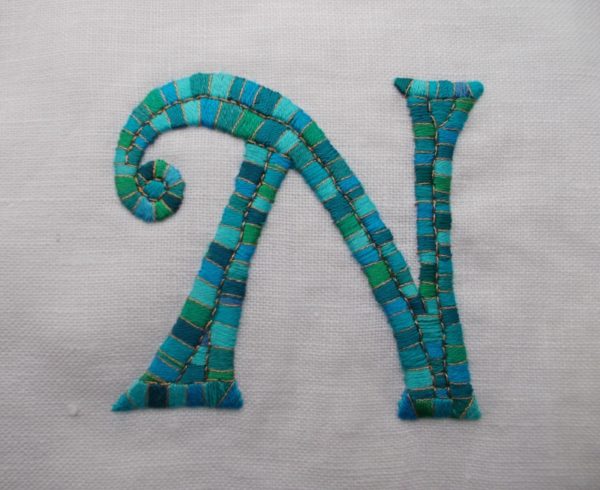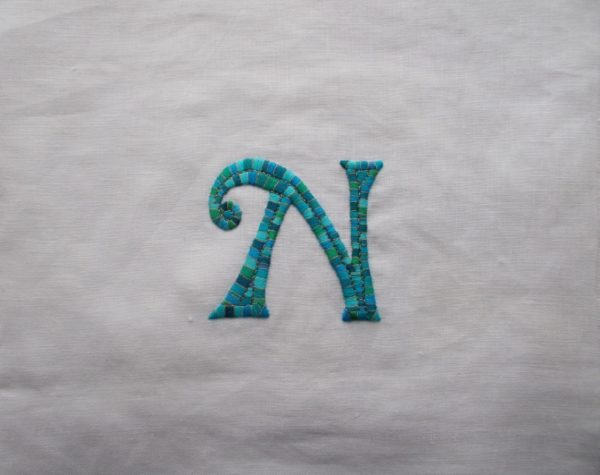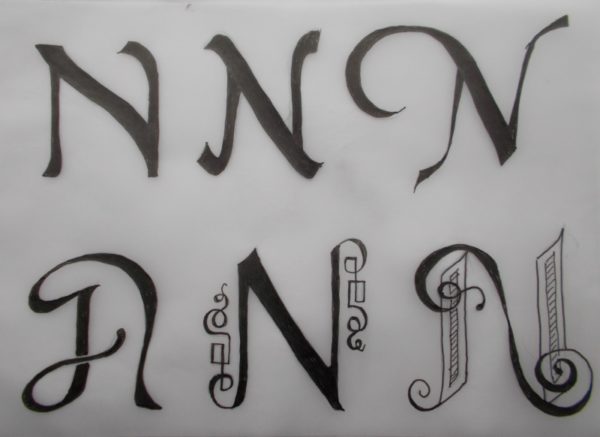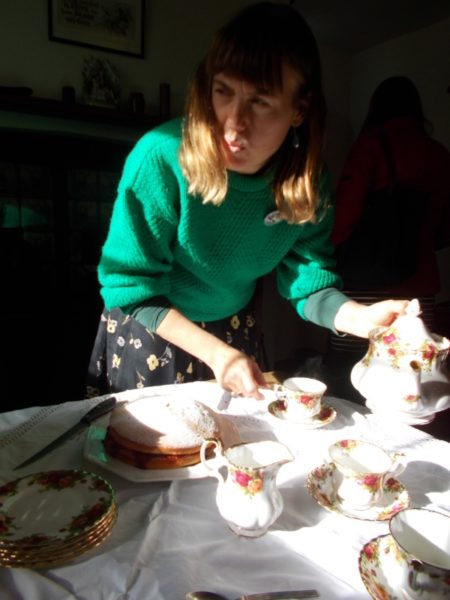
Embroidered letter N (hand embroidered by Mary Addison)
On Tuesday and across town for the last of the informal knitting sessions held at The Holst birthplace Museum. It’s a good walk of a half hour or so but architecturally delightful and never boring as I pass by a score or more of caryatids (in between the shop fronts in Montpellier), scores (most definitely in the plural) of classical columns of all major orders and a blacksmith’s dream of ironmongery (balconies and ornamental railings). When I worked in the library at Balliol College, Oxford, I thought Broad Street the most beautiful road to work in the world (with the Sheldonian by Christopher Wren, the Clarendon building in classical style, the 17C Museum of the History of Science, Victorian, Gothic and not so Gothic college buildings, a glimpse of the Bodleian and on top of the worst building in the street, belonging to Exeter College, one of Antony Gormley’s 7′ nude figures). Cheltenham, from the Montperllier Rotunda down and along the Promenade is pretty good too in a more civic sort of way, fine buildings on one side and two sets of public gardens on the other. Both roads terrific but different. But then you can’t really compare apples and pears, can you?

Embroidered letter N (hand embroidered by Mary Addison)
The temperature has dropped considerably recently, so the warmth of the Holst kitchen with its coal fired range and the sight of knitting friends already industriously chatting and working wool was very welcome. As promised, a Victoria sponge sat centre stage on the kitchen table – yet another beyond-the-call-of-duty production by the curator, Laura. A further one off knitting session was suggested for early December and the curator came very close to promising another series starting in the spring – perhaps one a month. She’s also keen to set up some sort of reading group and possibly also other craft based sessions. I offered to lead one on patchwork, which would be appropriate in a house of this period. Meanwhile back to knitting, which sadly didn’t last long. I began a lesson in cabling but this came to an abrupt halt when we were stymied by ambiguous (or just plain wrong) instructions in the pattern I wanted to follow. (Fingers crossed that once at home an online search will reveal an amendment to the pattern – but how irritating.) I put down my needles and gave full attention to chatting.

Sketches of various Ns found online
Cooking seems to have become the theme of this week. The grandson arrived with a tin of sticky toffee fairy cakes he’d made with one of his aunts and he and his mother then stationed themselves on the front doorstep to sell them to help save the coelacanth, a fish of ancient origin which is often described as a living fossil. Rain was in the air so we hurried the sale on by buying a few cakes for ourselves, and a good thing it was too as they were a delicious concoction of various ground nuts and dates. At 40p a cake the passers-by who kindly stopped to buy one and to hear a four year old’s explanation as to why the coelacanth needed saving would not have been disappointed.

Curator Laura Kinnear serving tea
My husband was keen to show the family the Holst Birthplace Museum and fortuitously this Saturday was one of their drop in period cooking sessions. We set off from home just as the rain came – not a little dispiriting for a four year old on a bike. By the time we reached the museum, the bike was balanced precariously across the hood of his sister’s buggy and his steps were dragging. Weary, wet children and museums don’t always make good partners and for a while things were tense. However, being asked to stir the drop scone mixture was a great pick me up for our thwarted cycle rider and he and the spoon were soon inseparable. Caraway biscuits, after an uncertain first bite, rapidly became firm favourites and three or four biscuits later, we imposed a ban – unsuccessful as the curator gave him some in a little paper bag as we left! My husband meanwhile enjoyed a slice of pale, fruity Queen cake, which included cream in its recipe and had a subtle and delicate flavour for a fruit cake (I just had a very little bite!) – why do we still not make this Victorian favourite today?
Family have returned to London but I’m off tomorrow to help with things there. Here is an N which I hope resembles the mosaic N I set out to emulate; the ‘grouting’ is gold thread.

10 Comments
It does look very “mosaicky” – and much easier than snipping corners off a mosaic tile!
And I’d have loved to hear the four-year-old’s explanation of saving the coelacanth..
Definitely easier to embroider than assemble out of bits of tiles!
I wish I could do justice to our coelacanth saving sale but my literary skills just weren’t up to it.
I love the colors of this one!
Thank you, Bev.
Lovely–both the N and the story.
Kind of you to say so Katie.
Mary, I enjoyed our Tuesday afternoons so much and felt unreasonably bereft today without the promise of one of Laura’s treats.
Coincidentally, years ago whilst on the Mozambican island of Inhaca, walking along the beach in the middle of nowhere, we came across a marine biology research centre. We were aghast, as this was a country that had just seen the horrors of two decades of civil war and yet this little centre had continued it’s work on study of the coelacanth despite the extreme difficulties, as there had been recent sightings in this area. True dedication.
Incidentally, the coelacanth has even been featured on Mozambican coins.
Hope you are staying warm, Sue.
I too thought of the calm serenity of our knitting sessions – especially alluring while elbow deep into making an industrial sized fish pie with mounds of washing next in line!
We loved the story of your Mozambique coelacanth research centre encounter which I related to the young man on his way to bed. Will research the research centre and see if we can send our meagre donation there. (I think it’s something to do with a school project, but I obviously wasn’t paying good enough attention).
https://clubofmozambique.com/news/inhaca-marine-biology-research-station-capacity-gets-boost/
This is the place…I am so happy that it still exists and is obviously getting licks of paint these days. It was very delapidated and under equipped when we were lucky enough to visit. Good news indeed!
Mary, do you ever sell the rights to digitally reproduce these letters? I am a book designer and I would love to purchase the rights to employ this alphabet as drop cap letters for a project I am working on. I am specifically interested in this “N” design, but I would be open to any full alphabets you have created.